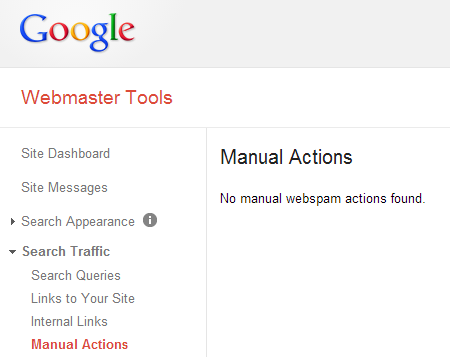"I used to rank for all sorts of relevant keywords and get tons of traffic from Google. Now my law firm website (or blog) doesn't appear anywhere in search results. What the heck happened?"
If your organic search traffic looks like the image above, there are a couple of things that might have happened.
First, you might have received a manual webspam action. The good news is that you can figure out whether you've received such an action really easily. Just log into Google Webmaster Tools and navigate to:
Search Traffic -> Manual Actions
Hopefully, it reads: No manual webspam actions found.

If it says anything else, you need to learn about Manual Actions and how to build your appeal to Google.
The bad news is that manual webspam actions are one of the ultimate smack-downs that you can get from Google (just shy of complete de-indexation). They are difficult to recover from and require a lot of time and effort. In many cases, you will be better served to just start over than to try to salvage an existing site.
Second, if you don't have a manual webspam action, your traffic may have been impacted by an algorithmic update. If website's organic search traffic plummeted in the last two or three years, it's likely the result of one or two (or combination of both) major Google updates. These are lovingly referred to as the Panda and Penguin updates.
According to Moz, the Panda update seemed to hit sites, "with thin content, content farms, sites with high ad-to-content ratios, and a number of other quality issues."
Generally, what that means is that you cranked out pages for the sake of cranking out pages, you were in Panda's cross-hairs.
Unfortunately, Google probably didn't send you an email to tell you that you were targeted by this algorithm update. You have to look for the signs (i.e. your traffic dropped off of a cliff correlating with the time one of the updates was implemented).
If you believe your site was hit by Panda, start reading here. If you're not sure, give us a ring, we're happy to provide our insights.
Perhaps you didn't churn out thin content but your site still suffered a massive traffic loss. Were you (or someone you were paying) building massive amounts of overly optimized anchor text links (i.e. links where the linking text was [personal injury attorney] or something like that)?
In that case, you might have suffered from the Penguin update. Again, this was an algorithmic update targeting sites that were trying to manipulate Google with link building activities.
Like Panda, Google didn't necessarily send out a notification to tell you that your site was impacted by this algorithmic update.
If you think you might have suffered from the Penguin update, start reading here. Your course of action is probably to contact other websites to see if you can get those links removed. Next, you might consider using Google's link disavowal tool.
Again, if you're not sure whether or not you were targeted by this update, we're happy to provide our opinion.
Finally, if you don't have a manual webspam action and you don't think you were impacted by these major Google updates, you may have some technical problem with your site.
Did you recently make any massive changes to your site (i.e. delete a directory, move pages, update your robots.txt or meta robots tags)? Is there a chance that you dropped Google Analytics code from pages? Are you seeing any major crawl or indexation errors in Google Webmaster Tools?
The good news is that if you lost traffic due to one of these common technical SEO issues, you should be able to recover fairly easily. Most of the time, the most difficult part is simply understanding what happened, how it happened and preventing it from happening again.
These are just some of the most common reasons we see law firm websites (and blogs) lose massive search traffic. Obviously, these are not the only reasons. If you see a major drop, don't panic. Use this post to begin your investigation.

Here's a recent Google SERP for "𝘄𝗵𝗼 𝗮𝗿𝗲 𝘁𝗵𝗲 𝗯𝗲𝘀𝘁 𝗰𝗮𝗿 𝗮𝗰𝗰𝗶𝗱𝗲𝗻𝘁 𝗹𝗮𝘄𝘆𝗲𝗿𝘀 𝗶𝗻 𝗽𝗵𝗶𝗹𝗮𝗱𝗲𝗹𝗽𝗵𝗶𝗮." Ads? ❌LSAs? ❌Local Pack? ❌Links? ❌ 🔷 AI Overview? ✅ 6 firms listed. Only one tiny 🔗. Click the 𝗦𝗵𝗼𝘄 𝗺𝗼𝗿𝗲 button? 𝗬𝗼𝘂 𝗴𝗲𝘁: Here's a more detailed look at some of these firms: THE PEARCE LAW FIRM, P.C.Edith Pearce, […]
On April 22, 2025, Google sent an email updating Local Services Ads Additional Terms for Providers: Subject: Action required: important updates to Local Service Ads Additional Terms Many people are arguing that lawyers cannot participate in Local Services Ads, as this would constitute a per se violation of the Rules of Professional Conduct related to […]
Conrad and I recently joined Zack at Lawyerist to record a conversation about AI and marketing. You might think that we spend the whole time on how lawyers can use AI to publish content. You'd be wrong. While AI can certainly support publishing, there are many more interesting ways to use it in legal marketing. […]
As more legal services consumers turn to ChatGPT for local law firm recommendations, a fascinating intersection between AI, search, and maps unfolds. While Google remains the undisputed leader in local business data, ChatGPT is increasingly becoming an entry point for searchers seeking legal representation. But here’s the kicker: instead of keeping users within its ecosystem, […]
When law firms contact us, they usually want to talk: • PPC Ads • SEO Rankings • Lead Generation Very few want to talk: • Brand • Trust & Recognition • Emotional Connection Admittedly, much of this concerns that AttorneySync is known for lead generation across those common digital channels. But even when we start […]
According to an October 2024 study by SE Ranking: "The legal niche triggers the highest percentage of AIOs (77.67%). The average number of links matched between the AI Overview resources and the top 20 search results was 6.49 for legal topics. AI Overviews for legal topics most frequently link to NYCourts.gov (114 links), YouTube.com (48 […]
I'm grateful for my friend, Charley Mann of Law firm Alchemy. If you're a lawyer, subscribe to his Free Email List. In a recent email, Charley calls out bad guru advice on hiring: "Trying to execute a major SEO improvement? You need to find people who will help you, instead of trying to DIY it […]
If you’ve spent any time on LinkedIn, you’ve likely seen posts from law firm SEO experts showing off charts with an “up and to the right” trajectory. These screenshots, often pulled from tools like Semrush or Ahrefs, are meant to signal SEO success. And it’s not just the agencies celebrating—𝗹𝗮𝘄 𝗳𝗶𝗿𝗺𝘀 𝘁𝗵𝗮𝘁 𝗵𝗮𝘃𝗲 𝗵𝗶𝗿𝗲𝗱 𝘁𝗵𝗲𝗺 […]
Meh, links! All things being equal, links still tend to move the dial more than any other factor in legal SERPs. Maybe links are having a diminishing impact internet-wide. But in my experience, quality links, especially relevant links (both topically and geographically), tend to improve law firm visibility in search more than most everything else. […]